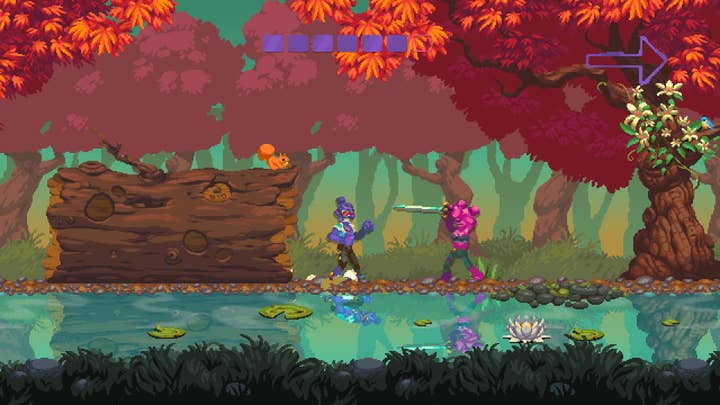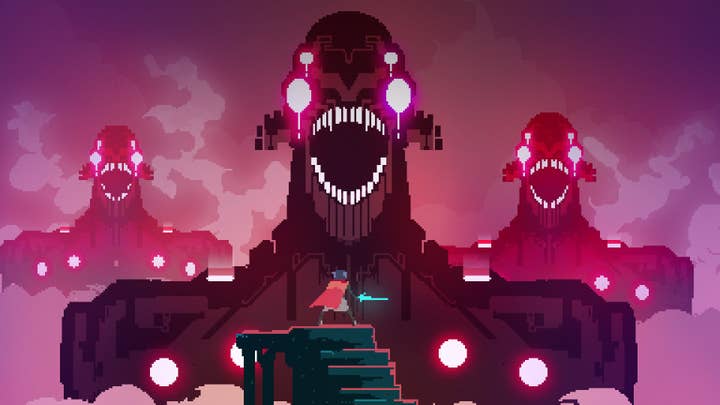The future of 2D gaming
YoYo Games' CTO Russell Kay speaks to developers about the benefits and burdens of building your game in two dimensions
I remember when I was a child playing Manic Miner and thinking, "This will never not be fun to me." And you know what? Even with my not fully formed, malleable kid brain, I was totally right. Manic Miner is still fun today, though there was a time where games of its ilk -- by which I mean 2D games -- were going the way of the dinosaur.
Around the late '90s and early 2000s, all of the most treasured video game franchises had transitioned over into 3D. Mario, Zelda, Donkey Kong, Metroid, Sonic, Castlevania, Metal Gear, and even Monkey Island had traded pixels for polygons as we entered this strange, new world.
Thankfully, 2D gaming later saw a resurgence, with most of these AAA series receiving 2D (or at least 2.5D) entries. And now we have popular indie games like Nuclear Throne, Hyper Light Drifter, and Super Meat Boy paving the way forward for what was nearly a lost art. Trends are always changing, however, and in a world smitten with blockbusters like Red Dead Redemption 2, Fortnite, and Overwatch, one can't help but wonder how 2D gaming will persevere going forward. So, to help us predict the future, we asked our panel of 2D game developers how they see this early form of gaming evolving.

But before we get to the future, first we need to understand the present. Why is 2D gaming still so important in the modern era? We were given a range of reasons, starting with the inherent accessibility 2D games offer.
"I can't tell you how many times I've seen someone with very little gaming experience pick up a 3D game, and spend the next 10 minutes staring at floors and ceilings, frustrated because they can't figure out how to look in the correct direction," says Seth Coster of Crashlands developer Butterscotch Shenanigans. "But with 2D, we tend to not have those kinds of problems."
This sentiment was echoed by Dan Johnston of Chequered Ink -- makers of Game Dev Dan vs Life -- who says: "2D games are easier to visualise and prototype quickly for developers. You don't have to build a big, complex environment in a beefy game engine to get an idea how your game idea is going to look. You can also make 2D games with a smaller and less experienced team."
YoYo Games head of development Mike Dailly adds: "It's still the fastest way of making games, and still the simplest interaction for casual users. 2D interfaces are everywhere, so casual gamers will always find these games simpler to use and more fun to play. The frustration of a 3D interface will drive many casual users from an app, not just games."
This isn't to say that 2D gaming is exactly easy to develop. In some ways, it can be even harder.
"It's a huge misconception that it's 'easier' or 'cheaper' to make a 2D game"
Jason Canam, Household Games
"It's a huge misconception that it's 'easier' or 'cheaper' to make a 2D game," says Jason Canam, founder of Way of the Passive Fist developer Household Games. "There are no shortage of challenges when making a 2D game. Art is often the biggest challenge. Levels need to be hand-drawn, even in pixel art, and minor changes always require updating and working with the art. There's no easy lighting adjustments, no camera tweaks. If it doesn't look good, it's being redrawn -- no way around it."
Coster offered a more specific example of how 2D gaming can actually be even more labour intensive than its 3D brethren: "One of the disadvantages of 2D is the massive amounts of texture space you need if you want to do something big. Instead of a 3D model with one texture, you may have the same character rendered 300 times in different poses. This puts some limitations on just how detailed you can get, or how high of resolution you can make your sprites, without bogging down GPUs."
Rivals of Aether developer Dan Fornace noted that environments can be difficult to keep interesting in a 2D game where the player scrolls by them quite quickly.
"One challenge is picking an art style that is able to be produced consistently throughout the whole game, (that) also stands out when compared to other games," he explains. "It is easier to make a mockup than it is to make a fully animated game with lots of content."
When asked what factors go into deciding whether to make a game in 2D or 3D, our panelists generally agreed that it came down to two things: the game concept, and target market.

"The rise of games like Flappy Bird -- or even Snake back in the day -- shows there is a monumental desire for simple, pick-up-and-play gameplay," says Dailly. "So, when building a new game, first think of what you'd like to make, then think of the target audience. If it's a game for the masses, you're wasting your time, and more importantly, money, making it 3D."
Johnston argues it depends on the genre: "If you're making a side-scrolling platformer with no need for a third dimension, you'll probably make life easy for yourself and pick 2D. If your idea involves a player exploring a detailed environment in three dimensions, with 360-degree movement on the ground and climbing/jumping, then you'll probably want to use 3D. I don't think I've ever had a project where it wasn't immediately obvious whether I should use 2D or 3D."
While 2D gaming has a lot of advantages in terms of accessibility, for developers and players alike, it's worth noting that not everything can be well implemented in 2D. When asked about this, the main comments we got were about immersion not being the same.
"3D has always been about realism and immersion," says Dailly. "If you're trying to make a player believe they are in a world, then yeah, 2D won't work. Really, the choice is what game do you want, not 'can' it be in 2D."

Another common answer we got regarding the limits of 2D involved racing games and aerial combat games.
"It speaks to the power of 2D that there are few genres that would just flat out work better in 3D," says David Galindo of Vertigo Gaming, the studio behind Cook, Serve, Delicious. "The only one that really comes to mind is racing. That was always a genre that was held back by its technical limitations, and while Super Mario Kart is still as fun as ever I think most players would easily be drawn to Mario Kart 9 rather than another SNES Mario Kart-type game."

Coster felt this way about flight simulators and dogfighting games: "You can try to approximate the movement on a 2D plane, but the feeling of flying around in 3D space is just something that you can't really create a 2D substitute for."
In terms of the cultural cache, our panelists couldn't agree on whether 2D gaming is given the same level of respect as its 3D counterpart.
"We've finally gotten past that mental barrier of 'cheap $10 small experiences' and now big 2D indie games are going for as high as $30 and players don't bat an eye," says Galindo. "That speaks to the level of acceptance that the audience has for 2D titles, and it just lets us create newer and bigger things. And higher prices for a lot of these experiences shows just how much audiences treat them as any other game on the market. It really has replaced that middle-tier price range of games that doesn't exist anymore."
Johnston agrees: "Gamers have always treated 2D games with respect. Some types of game just work and feel better in 2D. The original Donkey Kong, Kirby, and Sonic games were always far more fun than the attempted 3D outings and the fans of those series let the developers know that they wanted to go back to the classic 2D style of gaming."
"Some games just work and feel better in 2D. The original Donkey Kong, Kirby, and Sonic games were always far more fun than the attempted 3D outings"
Dan Johnston, Chequered Ink
Canam, however, disagrees, believing that the general populace still thinks of 2D games as "lesser" in value.
"Honestly, I don't think the audience considers 2D and 3D games to be of equal value," he says. "Even though some 2D games have proven to be the highest rated, acclaimed and best selling of the past few years, the truth is they all occupy a different headspace, and price point, as the high budget 3D blockbuster games."
Coster feels like this disparity is platform specific: "Mobile and Switch gamers don't seem to care too much whether a game is in 2D or 3D. They tend to focus a lot more on the substance of the game itself - the gameplay, the humor, the stories. But on the more 'hardcore' platforms that tend to push graphics and realism, I think 2D will still be lagging behind for a good long while."
Looking ahead, a lot of developers are excited about regarding 2D gaming. One of the most exciting developments we've seen in the medium has been how 2D aesthetics have evolved over the years.
"I'm glad to see many games experiment with new art styles and breaking away from traditional styles like pixel art," says Galindo. "Games that come to mind are Nidhogg 2, Dead Cells, Battle Chef Brigade. These all have unique styles that are instantly recognizable with a screenshot. I think we're going to see more unique looking games like that in the years to come."

Canam adds: "What we are already seeing is 2D games that aren't presented in pixel art. We're seeing amazing things done in watercolor paints, razor-sharp vector graphics and so much more. The art styles that are used will evolve just like game mechanics do."
Coster similarly felt like the visual variety possible in 2D will set it apart more and more in the days to come: "I think in the next decade, we'll see the level of detail and polish creeping up and up in 2D games, such that we get to experience games with gorgeous, high-resolution, hand-painted imagery. It's going to be great, and it'll really set 2D apart from 3D in a big way."
But it's not just about aesthetics, as there are new gameplay systems in 2D that are still being discovered all these years on.
"I feel like we've barely scratched the surface on what we can do in 2D," says Galindo. "For me, being able to take a gameplay concept and focus squarely on one plane lets you polish it and make it work in such a way that few 3D games can really master."
Fornace adds: "This generation has done a good job showing us that the art style needs to fit the gameplay and the game's context. Papers, Please would be a very different experience with any other art style and is a perfect marriage of graphics and gameplay. I think we will see more creative stuff done with 2D as time goes on."
Finally, Vlambeer co-founder Jan Willem Nijman felt similarly enthused about the future possibilities in 2D gaming, now that development tools are more readily available and experimental games are easier than ever to prototype.
"As making games is getting more accessible, and more people are getting access to making games, we'll be seeing all kinds of exciting new things pop up," he says. "I'm hoping for a whole new generation of people using games as a simple form of self-expression, just like drawing or making music. We have no idea what kind of stories and experiences will be told in the future -- that makes me super excited, and I can't wait to play it all."








